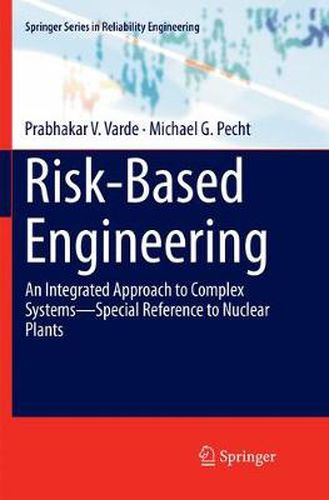Readings Newsletter
Become a Readings Member to make your shopping experience even easier.
Sign in or sign up for free!
You’re not far away from qualifying for FREE standard shipping within Australia
You’ve qualified for FREE standard shipping within Australia
The cart is loading…






This title is printed to order. This book may have been self-published. If so, we cannot guarantee the quality of the content. In the main most books will have gone through the editing process however some may not. We therefore suggest that you be aware of this before ordering this book. If in doubt check either the author or publisher’s details as we are unable to accept any returns unless they are faulty. Please contact us if you have any questions.
The book comprehensively covers the various aspects of risk modeling and analysis in technological contexts. It pursues a systems approach to modeling risk and reliability concerns in engineering, and covers the key concepts of risk analysis and mathematical tools used to assess and account for risk in engineering problems. The relevance of incorporating risk-based structures in design and operations is also stressed, with special emphasis on the human factor and behavioral risks.
The book uses the nuclear plant, an extremely complex and high-precision engineering environment, as an example to develop the concepts discussed. The core mechanical, electronic and physical aspects of such a complex system offer an excellent platform for analyzing and creating risk-based models. The book also provides real-time case studies in a separate section to demonstrate the use of this approach. There are many limitations when it comes to applications of risk-based approaches to engineering problems. The book is structured and written in a way that addresses these key gap areas to help optimize the overall methodology.
This book serves as a textbook for graduate and advanced undergraduate courses on risk and reliability in engineering. It can also be used outside the classroom for professional development courses aimed at practicing engineers or as an introduction to risk-based engineering for professionals, researchers, and students interested in the field.
$9.00 standard shipping within Australia
FREE standard shipping within Australia for orders over $100.00
Express & International shipping calculated at checkout
This title is printed to order. This book may have been self-published. If so, we cannot guarantee the quality of the content. In the main most books will have gone through the editing process however some may not. We therefore suggest that you be aware of this before ordering this book. If in doubt check either the author or publisher’s details as we are unable to accept any returns unless they are faulty. Please contact us if you have any questions.
The book comprehensively covers the various aspects of risk modeling and analysis in technological contexts. It pursues a systems approach to modeling risk and reliability concerns in engineering, and covers the key concepts of risk analysis and mathematical tools used to assess and account for risk in engineering problems. The relevance of incorporating risk-based structures in design and operations is also stressed, with special emphasis on the human factor and behavioral risks.
The book uses the nuclear plant, an extremely complex and high-precision engineering environment, as an example to develop the concepts discussed. The core mechanical, electronic and physical aspects of such a complex system offer an excellent platform for analyzing and creating risk-based models. The book also provides real-time case studies in a separate section to demonstrate the use of this approach. There are many limitations when it comes to applications of risk-based approaches to engineering problems. The book is structured and written in a way that addresses these key gap areas to help optimize the overall methodology.
This book serves as a textbook for graduate and advanced undergraduate courses on risk and reliability in engineering. It can also be used outside the classroom for professional development courses aimed at practicing engineers or as an introduction to risk-based engineering for professionals, researchers, and students interested in the field.